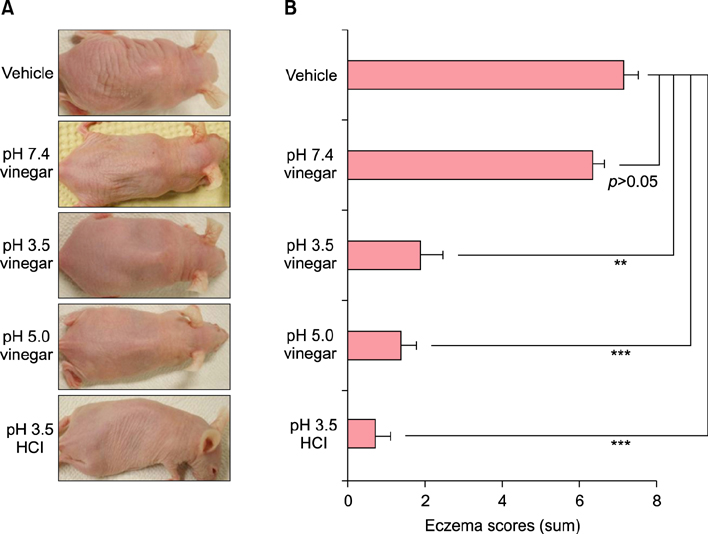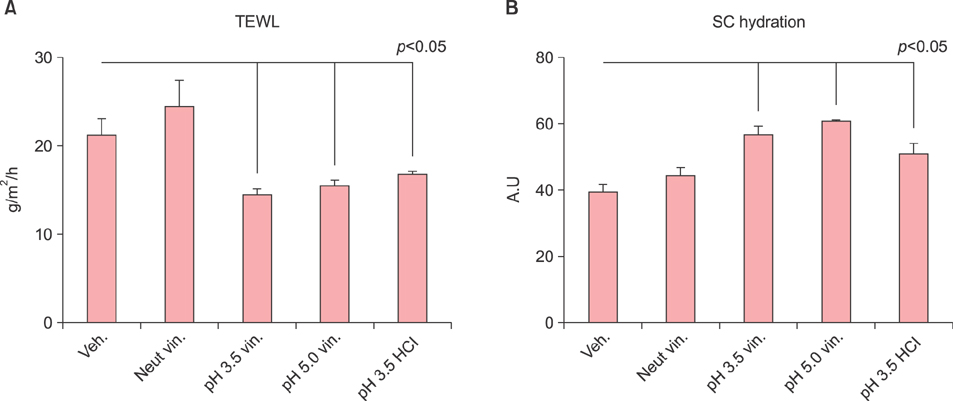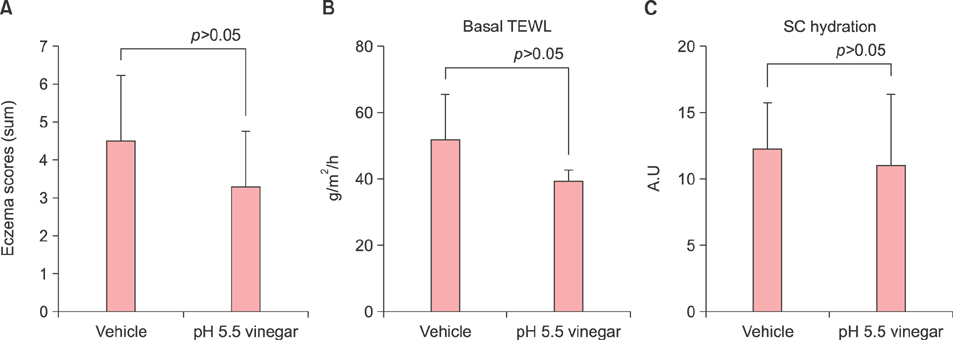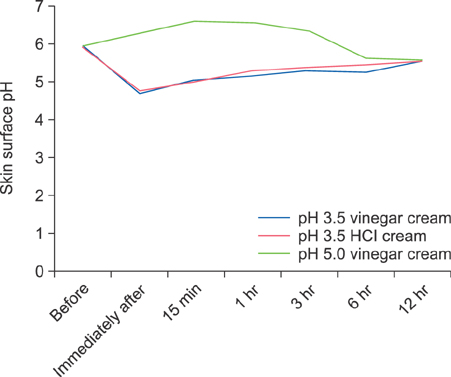Ann Dermatol.
2016 Dec;28(6):690-696. 10.5021/ad.2016.28.6.690.
Application of Topical Acids Improves Atopic Dermatitis in Murine Model by Enhancement of Skin Barrier Functions Regardless of the Origin of Acids
- Affiliations
-
- 1Department of Dermatology, Yonsei University Wonju College of Medicine, Wonju, Korea. choieh@yonsei.ac.kr
- KMID: 2368118
- DOI: http://doi.org/10.5021/ad.2016.28.6.690
Abstract
- BACKGROUND
The acidic pH of the stratum corneum (SC) is important for epidermal permeability barrier homeostasis. Acidification of the skin surface has been suggested as a therapeutic strategy for skin disorders such as atopic dermatitis (AD).
OBJECTIVE
We performed an animal study to evaluate the usefulness of acidification of SC for inhibition of AD lesions and to find out if the therapeutic effect of vinegar is attributable to its herbal contents, rather than its acidity.
METHODS
Five groups of six oxazolone-treated (Ox)-AD mice were treated for three weeks with creams of different acidity: vehicle cream alone (pH 5.5), neutralized vinegar cream (pH 7.4), pH 5.0 vinegar cream, pH 3.5 vinegar cream, and pH 3.5 hydrogen chloride (HCl) cream. Also, we have compared two groups of Ox-AD mice treated with pH 5.5 vehicle cream or pH 5.5 vinegar cream.
RESULTS
Ox-AD mice treated with acidic creams exhibited fewer AD-like lesions, had significantly lower eczema scores, decreased basal by transepidermal water loss (TEWL), and increased SC hydration compared to the groups given only vehicle and neutral cream. There was no significant difference between the acidic vinegar and HCl groups. Between the groups treated with vehicle and pH 5.5 vinegar cream, there was no difference in eczema score, basal TEWL and SC hydration.
CONCLUSION
Application of topical acids, regardless of their source materials, inhibits the development of AD lesions by maintenance of skin surface pH and skin barrier function in murine model.
Keyword
MeSH Terms
Figure
Reference
-
1. Hachem JP, Crumrine D, Fluhr J, Brown BE, Feingold KR, Elias PM. pH directly regulates epidermal permeability barrier homeostasis, and stratum corneum integrity/cohesion. J Invest Dermatol. 2003; 121:345–353.
Article2. Mauro T, Holleran WM, Grayson S, Gao WN, Man MQ, Kriehuber E, et al. Barrier recovery is impeded at neutral pH, independent of ionic effects: implications for extracellular lipid processing. Arch Dermatol Res. 1998; 290:215–222.
Article3. Fluhr JW, Kao J, Jain M, Ahn SK, Feingold KR, Elias PM. Generation of free fatty acids from phospholipids regulates stratum corneum acidification and integrity. J Invest Dermatol. 2001; 117:44–51.
Article4. Devillers AC, de Waard-van der Spek FB, Mulder PG, Oranje AP. Treatment of refractory atopic dermatitis using ‘wet-wrap’ dressings and diluted corticosteroids: results of standardized treatment in both children and adults. Dermatology. 2002; 204:50–55.
ArticleKorting HC., Hübner K., Greiner K., Hamm G., Braun-Falco O. Differences in the skin surface pH and bacterial microflora due to the long-term application of synthetic detergent preparations of pH 5.5 and pH 7.0. Results of a crossover trial in healthy volunteers. Acta Derm Venereol. 1990. 70:429–431.6. Elias PM. The skin barrier as an innate immune element. Semin Immunopathol. 2007; 29:3–14.
Article7. Hachem JP, Behne M, Fluhr J, Feingold KR, Elias PM. Increased stratum corneum pH promotes activation and release of primary cytokine from the stratum corneum attributable to activation of serine proteases. J Invest Dermatol. 2002; 119:258.8. Behne MJ, Meyer JW, Hanson KM, Barry NP, Murata S, Crumrine D, et al. NHE regulates the stratum corneum permeability barrier homeostasis. Microenvironment acidification assessed with fluorescence lifetime imaging. J Biol Chem. 2002; 277:47399–47406.9. Mao-Qiang M, Jain M, Feingold KR, Elias PM. Secretory phospholipase A2 activity is required for permeability barrier homeostasis. J Invest Dermatol. 1996; 106:57–63.
Article10. Mazereeuw-Hautier J, Redoules D, Tarroux R, Charveron M, Salles JP, Simon MF, et al. Identification of pancreatic type I secreted phospholipase A2 in human epidermis and its determination by tape stripping. Br J Dermatol. 2000; 142:424–431.
Article11. Krien PM, Kermici M. Evidence for the existence of a self-regulated enzymatic process within the human stratum corneum -an unexpected role for urocanic acid. J Invest Dermatol. 2000; 115:414–420.
Article12. Behne MJ, Barry NP, Hanson KM, Aronchik I, Clegg RW, Gratton E, et al. Neonatal development of the stratum corneum pH gradient: localization and mechanisms leading to emergence of optimal barrier function. J Invest Dermatol. 2003; 120:998–1006.
Article13. Fluhr JW, Behne MJ, Brown BE, Moskowitz DG, Selden C, Mao-Qiang M, et al. Stratum corneum acidification in neonatal skin: secretory phospholipase A2 and the sodium/hydrogen antiporter-1 acidify neonatal rat stratum corneum. J Invest Dermatol. 2004; 122:320–329.
Article14. Choi EH, Man MQ, Xu P, Xin S, Liu Z, Crumrine DA, et al. Stratum corneum acidification is impaired in moderately aged human and murine skin. J Invest Dermatol. 2007; 127:2847–2856.
Article15. Fluhr JW, Elias PM. Stratum corneum pH: formation and function of the ‘acid mantle’. Exog Dermatol. 2002; 1:163–175.
Article16. Hatano Y, Man MQ, Uchida Y, Crumrine D, Scharschmidt TC, Kim EG, et al. Maintenance of an acidic stratum corneum prevents emergence of murine atopic dermatitis. J Invest Dermatol. 2009; 129:1824–1835.
Article17. Hachem JP, Roelandt T, Schürer N, Pu X, Fluhr J, Giddelo C, et al. Acute acidification of stratum corneum membrane domains using polyhydroxyl acids improves lipid processing and inhibits degradation of corneodesmosomes. J Invest Dermatol. 2010; 130:500–510.
Article18. Hachem JP, Man MQ, Crumrine D, Uchida Y, Brown BE, Rogiers V, et al. Sustained serine proteases activity by prolonged increase in pH leads to degradation of lipid processing enzymes and profound alterations of barrier function and stratum corneum integrity. J Invest Dermatol. 2005; 125:510–520.
Article19. Holleran WM, Takagi Y, Uchida Y. Epidermal sphingolipids: metabolism, function, and roles in skin disorders. FEBS Lett. 2006; 580:5456–5466.
Article20. Hachem JP, Houben E, Crumrine D, Man MQ, Schurer N, Roelandt T, et al. Serine protease signaling of epidermal permeability barrier homeostasis. J Invest Dermatol. 2006; 126:2074–2086.
Article21. Lee HJ, Lee NR, Jung M, Kim DH, Choi EH. Atopic march from atopic dermatitis to asthma-like lesions in NC/Nga mice is accelerated or aggravated by neutralization of stratum corneum but partially inhibited by acidification. J Invest Dermatol. 2015; 135:3025–3033.
Article22. Lee HJ, Yoon NY, Lee NR, Jung M, Kim DH, Choi EH. Topical acidic cream prevents the development of atopic dermatitis- and asthma-like lesions in murine model. Exp Dermatol. 2014; 23:736–741.
Article23. Lee NR, Lee HJ, Yoon NY, Kim D, Jung M, Choi EH. Acidic water bathing could be a safe and effective therapeutic modality for severe and refractory atopic dermatitis. Ann Dermatol. 2016; 28:126–129.
Article24. Lee HJ, Jung M, Kim JH, Yoon NY, Choi EH. The effect of adipose-derived stem cell-cultured media on oxazolone treated atopic dermatitis-like murine model. Ann Dermatol. 2012; 24:181–188.
Article25. Man MQ, Hatano Y, Lee SH, Man M, Chang S, Feingold KR, et al. Characterization of a hapten-induced, murine model with multiple features of atopic dermatitis: structural, immunologic, and biochemical changes following single versus multiple oxazolone challenges. J Invest Dermatol. 2008; 128:79–86.
Article26. Suto H, Matsuda H, Mitsuishi K, Hira K, Uchida T, Unno T, et al. NC/Nga mice: a mouse model for atopic dermatitis. Int Arch Allergy Immunol. 1999; 120:Suppl 1. 70–75.
Article27. Yang F, Tanaka M, Wataya-Kaneda M, Yang L, Nakamura A, Matsumoto S, et al. Topical application of rapamycin ointment ameliorates Dermatophagoides farina body extract-induced atopic dermatitis in NC/Nga mice. Exp Dermatol. 2014; 23:568–572.
Article28. Elias PM. Stratum corneum defensive functions: an integrated view. J Invest Dermatol. 2005; 125:183–200.
Article29. Fluhr JW, Mao-Qiang M, Brown BE, Hachem JP, Moskowitz DG, Demerjian M, et al. Functional consequences of a neutral pH in neonatal rat stratum corneum. J Invest Dermatol. 2004; 123:140–151.
Article30. Yoon NY, Jung My, Kim DH, Lee HJ, Choi EH. Topical glucocorticoid or pimecrolimus treatment suppresses thymic stromal lymphopoietin-related allergic inflammatory mechanism in an oxazolone-induced atopic dermatitis murine model. Arch Dermatol Res. 2015; 307:569–581.
Article31. Korting HC, Megele M, Mehringer L, Vieluf D, Zienicke H, Hamm G, et al. Influence of skin cleansing preparation acidity on skin surface properties. Int J Cosmet Sci. 1991; 13:91–102.
Article32. Ali SM, Yosipovitch G. Skin pH: from basic science to basic skin care. Acta Derm Venereol. 2013; 93:261–267.
Article
- Full Text Links
- Actions
-
Cited
- CITED
-
- Close
- Share
- Similar articles
-
- Epidermal Lipid Homeostasis
- Significance of Skin Barrier Dysfunction in Atopic Dermatitis
- Quantitative determination of 12-hydroxyeicosatetraenoic acids by chiral liquid chromatography tandem mass spectrometry in a murine atopic dermatitis model
- Long Term Treatment Concepts and Proactive Therapy for Atopic Eczema
- Skin Barrier Dysfunction in the Scalp, Nails, and Lips in Patients with Atopic Dermatitis





